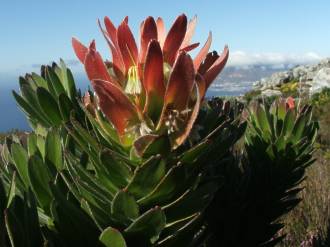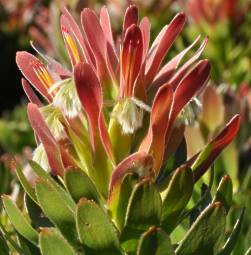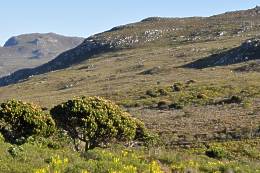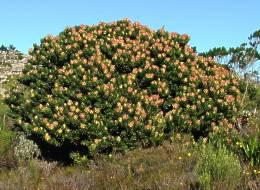Mimetes fimbriifolius
Mimetes fimbriifolius Salisb. ex Knight
Family: Proteaceae
Common names: tree pagoda, cowl pagoda, fringed pagoda (Eng.); kreupelboom, maanhaarstompie (Afr.)
SA Tree No: 72.2
Introduction
Mimetes fimbriifolius is a beautiful rounded tree that was once common on Table Mountain, but its numbers have been greatly depleted by harvesting for fire wood since the eighteenth century. It is endemic to the Cape Peninsula, and good populations of this species continue to survive on the southern Peninsula especially at Silvermine and at Cape Point.

Description
Description
At maturity Mimetes fimbriifolius develops into a stout, densely branched, wide-spreading tree up to 4 m tall and 5 m in diameter. It produces a thick, corky trunk between 25 and 60 cm in diameter which branches about half a metre above soil level. The branches are stout, stocky and repeatedly divide to produce interlocking branchlets to form a dense, rounded crown. The general appearance of this species is of rounded forms dotted or grouped, looking like vegetative tortoise shells in the fynbos landscape. Its leaves are numerous, upwardly overlapping, and so closely packed together at the ends of the branches that they obscure the branch structure of specimens in their prime. Old, senescent specimens become more ragged and may lose shape and expose the gnarled branch structure beneath. The leaves are oblong to elliptic and have a thick fringe of white pubescent hairs on the margins.

Mimetes flower heads are cylindrical and about 60-80 mm long and 60-70 mm across and consist of a combination of flower headlets, coloured leaves and bracts. Each flower head consists of up to 15 headlets (groups of flowers) which are borne in the axils of the uppermost foliage leaves of a flowering branch. There are four to seven flowers in each headlet and each headlet is clasped from above by a reddish yellow, cowl-shaped leaf. The styles are 45-50 mm long and red. The pollen presenter is 5-7 mm long and spindle-shaped. Mimetes fimbriifolius is generally less colourful than M. cucullatus, but some trees produce lovely red leaves at the ends of flowering branches during flowering and provide spectacularly colourful tree specimens. This colouring of the leaves around the flower heads is variable and a tree that displays magnificent colour in one year may not do so in another year. The fruits are small and dry and contain a single seed, and do not split open when ripe. They are commonly referred to as seeds. Flowering may occur all year, but mainly from July to December, with a peak in September.
Conservation Status
Status
This species is restricted to the Cape Peninsula, with most of its populations within protected areas. Its classification in the Red list is Rare.

Distribution and habitat
Distribution description
Mimetes fimbriifolius is endemic to the Cape Peninsula from Table Mountain in the north to Cape Point. It grows on rocky slopes and flats from 0–1000 m. At its northerly end it grows above the 300 m contour, but occurs at lower altitudes further south such as at Cape Point where it may even grow near sea level. It shows a preference for rocky montane habitats, but may also be found on open fynbos slopes or plateaus.
Derivation of name and historical aspects
History
R.A. Salisbury established Mimetes as a genus in 1807 after subdividing Linnaeus's genus Leucadendron. The name was derived from a Greek word meaning ‘to imitate', probably referring to the leaves that are remarkably similar to those of some leucospermums such as Leucospermum conocarpodendron which is found growing with Mimetes fimbriifolius. Its specific name ‘fimbriifolius' refers to the fringe of hairs that is found on the margins of the leaves and is an important diagnostic character.
Herman Boerhaave wrote about Mimetes fimbriifolius in 1720 describing it as a beautiful tree on the upper parts of Table Mountain. He produced an engraving of this species which was published in his Index alter plantarum. A colour copy of Boerhaave's illustration can be found in the seventeenth manuscript volume entitled Icones plantarum et animalium which is housed in the Africana Museum in Johannesburg. In this volume it was given the common name ‘kreupelboom' (crippled tree) which was the name given to several large proteas that were exploited for fuel. This may explain why this species is so uncommon in the northern parts of the Cape Peninsula.
William Burchell, the famous English traveller, describes using Mimetes fimbriifolius for fire wood during his ascent of Table Mountain in 1811.
Ecology
Ecology
Mimetes fimbriifolius is the largest and longest-lived of all Mimetes species. It is very slow growing, and ten years may pass between its seed germinating and the first flowering although some specimens may flower earlier, given favourable conditions. It is estimated that many specimens reach an age of between 40 and 60 years and some may get as old as 100 years.
Mimetes fimbriifolius grows on well-drained, sandy, nutrient-poor soils. It receives relatively high rainfall exceeding 1000 mm per annum in the central and northern areas of the Cape Peninsula. At Cape Point it receives considerably less rain, under 700 mm, but this is made up by moisture-laden summer south-easter clouds and cooler temperatures because of the close proximity of the sea.
All members of the genus Mimetes have evolved nectar-rich flowerheads adapted to pollination by birds. The brightly coloured bracts and styles in shades of red and yellow are visually attractive to birds. Sugarbirds appear to be the primary pollinators of most Mimetes species.
Mimetes fimbriifolius forms part of fynbos, a fire-adapted flora. The adult plants are re-seeders and hence unable to resprout from a rootstock. As such, they are killed by fire, and the survival of their fruit is essential for survival of the species. Fire in fynbos is cyclical, but a necessary phenomenon, with the intervals between fires varying. The arrival of man and particularly the colonization from Europe has greatly increased the frequency of fire and reduced the intervals between burns. This has implications for the various Mimetes species. Mimetes cucullatus is a re-sprouter and easily survives and thrives on fire. Other species such as Mimetes hirtus and M. stokoei are killed by fire. These species grow quickly and can flower as early as twenty four months after germinating and produce plenty of seed relatively quickly. They both age quickly and become moribund by the time they are ten to fifteen years old. They are likely to thrive if burnt approximately every decade, but long periods between burns might reduce the viability of their seed reserves in the soil. The slow-growing tree species such as Mimetes arboreus and M. fimbriifolius require different natural circumstances. They take a long time to reach sexual maturity and live much longer. They usually take more than ten years to produce significant numbers of flowers and start producing seeds. These species are therefore much more susceptible to too frequent fires. As a result some areas of the Cape Peninsula have been denuded of Mimetes fimbriifolius.
Mimetes fimbriifolius also has another fire survival strategy. It has to survive the early years between germination and flowering. It achieves this by producing thick, fire-resistant bark on its trunk and lower branches. If it is burnt it can re-grow from shoots that remain protected under the bark layer (epicormic shoots) on the upper branches. This helps this species survive the occasional fire, but repeated burning can be fatal. Mimetes fimbriifolius and M. arboreus therefore require longer intervals between burns, probably at least thirty years.
All Mimetes species are mymecochorus which means their seeds are dispersed by ants. The ants are attracted to a protein-rich appendage on the seed known as elaiosome. There is a chemical attractant present in this structure on the ends of the fruit. This quickly attracts ants and they drag the fruit into the protection of their underground nests. Different ant species are attracted to the fruit, but the main ant associated with this symbiotic relationship is the pugnacious ant, Anoplolepis custodiens. The ants benefit by feeding on the protein-rich elaiosomes. The plant benefits in different ways. The ants quickly gather the seeds and bury them where they are safe from birds and rodents. They also help to disperse the seeds and store them in their nutrient-rich, humus-filled nests. The seeds are carried and stored deep enough underground to protect them from fire and still within reach of the heat of fire necessary to stimulate their germination. The fruit are able to live for long periods of time underground and germinate after fire, when they are triggered by various cues such as changes in temperature, pH and oxygen levels in the ants' nest.
Uses
Use
Mimetes fimbriifolius used to be a source of fire wood before it was protected.
Growing Mimetes fimbriifolius
Grow

Mimetes fimbriifolius has been the most overlooked Mimetes species in horticulture. It is a robust and attractive species with superb seasonal colouring. It has a much higher chance of surviving on its own roots, whereas many other Mimetes species need to be grafted onto hardy rootstocks and even then are difficult to grow. Only Mimetes cucullatus is easier to grow.
Propagation and cultivation
Mimetes fimbriifolius can be propagated from seeds, but seeing that these are difficult to acquire, propagation by means of cuttings is the preferred method. Sow seed in late summer to autumn (March–April). Use a well-drained medium, e.g. one of two parts coarse sand to one part leaf mould and one part loam. Cover the seeds with coarse, clean sand or milled bark and keep warm and moist. Seeds need alternating cold night and warm day temperatures to initiate germination, 4–10°C to 15–20°C, typical of autumn in the Western Cape. Germination can be induced if the seeds are soaked in a 1% solution of hydrogen peroxide for 24 hours. This oxygenates the seed and softens and loosens the seed coat, which should be rubbed off. Watering the seed tray with a fungicide will also prevent fungal disease. Germination takes 1 to 2 months and the young seedlings are ready to be potted up as soon as they have developed their first set of true leaves.
Cuttings should be either tip cuttings or side shoots taken as heel cuttings. The latter are cuttings taken where a side shoot is pulled off the main stem in such a way that part of the main stem comes off along with the cutting, thereby giving the appearance of a heel.
The cutting material must be 100–120 mm long, approximately as thick as a finger, and should be young but not too soft. Apply the 'little finger test', i.e. material should resist when one attempts to bend it with one's little finger. A good time to take cuttings is March when the new shoots have emerged and hardened off, but cuttings root easily at most times of the year. The cuttings must be kept cool after harvesting. Cuttings must be treated with a rooting hormone for semi-hardwood prior to setting in a rooting medium of 50:50 milled pine bark with polystyrene for drainage. Cuttings should be placed in 90 mm pots or large compartmented trays in well-aerated mist units with heating under the trays. It is essential that they are kept damp in the mist unit. Mimetes fimbriifolius is easy to root providing the correct methods are followed. Rooting may start after six weeks but can take up to three or four months.
In the event of callous formation, instead of roots, remove the cutting, damage the callous, and reapply rooting hormone. Place the cutting in a clean rooting medium and rooting should take place soon thereafter. Once the cuttings have rooted, they should be hardened off for three weeks and then planted into suitable containers. The planted cuttings should be kept wet at all times.
The planting medium should consist of sand with a high humic and low nutrient content. This can be attained by using sandy soil (when available) to which a small amount of peat (maximum 20%) can be added. Do not add compost to the soil. Alternatively, a sandy fynbos mix can be created using acid river sand and composted pine bark or pine needles in equal parts.
Feed the plants every six weeks with ammonium sulphate and magnesium sulphate by dissolving three to four heaped teaspoons of each in 10 litres water and give each plant a cupful at a time. This will ensure a good balance of growth between roots and leaves. Water them regularly, but do not overwater, as the medium must be allowed to dry out a little between watering.
Pests
Mimetes fimbriifolius does not appear to be very susceptible to the root rot fungus Phytophthora, but it is vulnerable to drought and heat stress.
Planting
The plants may need toughening up prior to being planted out in a garden. Expose them to sunlight and fewer nutrients if necessary.
Plant Mimetes fimbriifolius in well-drained areas such as rockeries, on slopes and in gardens along the Peninsula or the western Cape coast. Provide protection from excessive heat by planting them together with plants that give a certain degree of cooling shade for the surrounding soil. Good examples of companion plants are Elegia tectorum, Elegia capensis, hardy ericas such as E. glandulosa and E. discolor and Agathosma ovata. The soil should be mulched but not dug over, as this will disturb the roots.
References
- Goldblatt, P. & Manning, J. 2000. Cape Plants. A conspectus of the Cape flora of South Africa. Strelitzia 9. National Botanical Institute, Cape Town & Missouri Botanical Garden Press.
- Paterson-Jones, J.C. 1978. Mimetes. Veld & Flora 64: 78-80.
- Raimondo, D., Von Staden, L., Victor, J.E., Helme, N.A., Turner, R.C., Kamundi, D.A. & Manyama, P.A. (eds). 2009. Red List of South African plants. Strelitzia 25. South African National Biodiversity Institute, Pretoria.
- Rebelo, T. 1995. Sasol proteas: a field guide to the proteas of southern Africa. Fernwood Press, Vlaeberg, Cape Town.
- Rebelo, T. 2000. Field guide to the proteas of the Cape Peninsula. Protea Atlas Project, Cape Town.
- Rourke, J.P. & Lincoln, T. 1982. Mimetes: an illustrated account of Mimetes Salisbury and Orothamnus Pappe, two notable Cape genera of the Proteaceae. Tiyan Publishers, Cape Town.
- Rourke, J.P. 1984. A revision of the genus Mimetes Salisb. (Proteaceae). Journal of South African Botany 50: 171-236.
- Vogts, M. 1982. South Africa's Proteaceae: know them and grow them. Struik, Cape Town.
Credits
Anthony Hitchcock
Kirstenbosch National Botanical Garden
August 2010
Plant Attributes:
Plant Type: Tree
SA Distribution: Western Cape
Soil type: Sandy
Flowering season: Spring, Early Summer, Winter
PH: Acid
Flower colour: Red, White, Yellow
Aspect: Full Sun
Gardening skill: Average, Challenging
Special Features:
Horticultural zones







Rate this article
Article well written and informative
Rate this plant
Is this an interesting plant?
Login to add your Comment
Back to topNot registered yet? Click here to register.